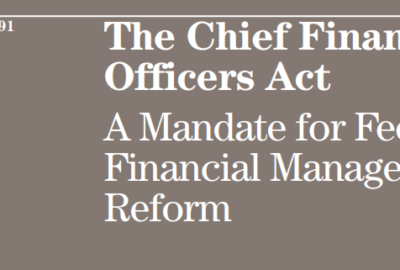
GAO says these agencies didn’t follow employee reassignment rules
Senior Executive Service members are people who, in theory, are capable of moving into just about any agency to help out. But there are rules to how and when they...
Best listening experience is on Chrome, Firefox or Safari. Subscribe to Federal Drive’s daily audio interviews on Apple Podcasts or PodcastOne.
Senior Executive Service members are people who, in theory, are capable of moving into just about any agency to help out. They are therefore subject to reassignment. But there are rules to how and when they can be moved around. Four agencies didn’t always follow those rules. Federal Drive with Tom Temin got the details from the acting director for Strategic Issues at the Government Accountability Office, Michelle Rosenberg.
Interview transcript:
Tom Temin: Mrs. Rosenberg, nice to have you on.
Michelle Rosenberg: Thanks, Tom, nice to be with you today.
Tom Temin: So first of all review for us that aspect of the Senior Executive Service, the fact of portability and they can kind of drop into any agency that might need some managerial help. And in theory, they have the ability to give that help regardless of the mission.
Michelle Rosenberg: That’s correct, Tom. So senior executives are expected to have leadership and management skills and a broad perspective of the government. And in fact, the Senior Executive Service was created in part for the purpose of ensuring the executive management of the federal government was responsive to the needs policies and goals of the nation. Given that, part of ensuring the responsiveness of the federal government was the ability for agencies to reassign senior executives to best accomplish the agency missions. And these reassignments can have really important benefits for meeting evolving priorities. They can promote executive development and engagement and improve agency mission delivery and collaboration.
Tom Temin: Now, as I mentioned at the beginning, there are rules that govern, you can’t just arbitrarily shoved them around, correct? What are some of those strictures on how they can be reassigned and who can reassign them?
Michelle Rosenberg: Right, there are rules. The most pertinent rule is that there are two periods, they’re called moratorium periods, in which agencies cannot involuntarily reassign the career SES members. So the first of these periods is 120 day period, after the appointment of a new agency head. So this is like when there’s a new department leader or a new secretary. And the second is also 120 day period. And it occurs when there’s the appointment of what’s referred to as a new non-career supervisor. That’s basically a political appointee that is the direct supervisor of the individual. During these two moratorium periods, agencies can make voluntary reassignment. So in other words, as long as the senior executive agrees to the reassignment and waive that moratorium period, the agencies can reassign them, but it’s important for that waiver of the moratorium period to be in writing. I think it’s important to know, Tom, that outside of these moratorium periods, a senior executive who fails to take a reassignment can be removed from their position. And that’s why it’s very important that the senior executives be informed if the reassignment occurs during a moratorium period, and that they waive that period and truly are voluntarily taking that new assignment.
Tom Temin: Sure. So I guess the moratorium was put in place by Congress, ultimately, to just to make sure that political appointees can’t arbitrarily clean house, for example, if they come in.
Michelle Rosenberg: Exactly. I think part of the expectation is that it wanted to protect senior executives from arbitrary and capricious actions. OPM is the Office of Personnel Management who is responsible for the overall management of the Senior Executive Service. And they’ve noted that part of the point of this moratorium period is to allow for kind of a get to know you, opportunity for the new agency head or the new political appointee supervisor to understand the strengths, skills and abilities of their senior executives so they can know where they are best positioned to help the agency achieve its mission.
Tom Temin: Sure, the political might come in to the decide, hey some of these swamp rats aren’t so bad after all. So you looked at four agencies? Why these four and which four were they and what did you find with respect to reassigning SESers?
Michelle Rosenberg: So we looked at the Department of Commerce, Energy, Housing and Urban Development, or HUD and the Department of Interior. We selected these agencies because they were among those with the highest percentage of reassignments in fiscal year 2017. That was the year we had most complete data for, and that’s overall reassignments. Unfortunately, we found that the selected agencies couldn’t always demonstrate that they hadn’t met the requirements for these reassignments. And this was especially the case for reassignments when there was that new political appointee supervisor. For example, we found that Commerce didn’t maintain any of the required documentation. So they couldn’t document to us that the SES members were informed of the moratorium period and actually waived that moratorium period. Similar HUD and Interior did not seek written waivers for reassignments when there was that new political appointee supervisor. The other thing we found is that the Office of Personnel Management, as I mentioned before, they have oversight of the management of the Senior Executive Service. But unfortunately, they have not been monitoring agencies reassignments to make sure that agencies were following the rules and OPM guidance.
Tom Temin: Interesting. It sounds almost as if, and maybe you know this, but tell me if you don’t know it, that they weren’t even aware of the rules, perhaps these incoming political appointees?
Michelle Rosenberg: I think in some cases, the agencies were not informed about the non-career supervisor, the moratorium related to a new political appointee. In other cases, they may have been aware of it but for example, in Commerce, they had delegated the responsibility for obtaining these waivers to their bureaus and the bureaus either were not aware or did not retain the documents that they were supposed to.
Tom Temin: And just trying to imagine the situation, did any of the reassigned people in the SES complain? Were there any complaints that got to, I don’t know what ears they would go to, someone at OPM?
Michelle Rosenberg: That’s not something that we included in the scope of our review. I do know that the Office of Inspector General at the Department of Interior had done work looking at the management of the SPS back in 2018. That was some of the impetus for the request. And there were concerns there more broadly about the management of the SES at Interior.
Tom Temin: And is it possible to tell from the data where people were sent, that is to say where they sent cross country or to the deep south or something from Washington or vice versa?
Michelle Rosenberg: There were some instances where the reassignments included a relocation. In the cases where it did involve a relocation, there are some additional requirements about notification, there’s at least I believe it’s a 60 day advanced notification requirement. And agencies are also supposed to consult with the senior executive before such a relocation.
Tom Temin: And I can guess what your recommendations might have been, but what are they?
Michelle Rosenberg: Sure, so we made a total of four recommendations, one each to Commerce, HUD and Interior. And as you probably suspect, those recommendations were to improve their career SES reassignment processes. This could include for example, by implementing and finalizing procedures to make sure that a written waiver is obtained before a reassignment during the moratorium period occurred. And then our fourth recommendation was to the Office of Personnel Management. As I mentioned previously, they have oversight authority to monitor career SES reassignment, but they haven’t been doing so. As I suspect you can glean, our recommendation was for them to use that oversight authority to monitor agencies reassignment of the senior executives.
Tom Temin: Did they generally concur with those recommendations?
Michelle Rosenberg: Commerce, HUD and Interior all concurred with the recommendation we made to them, and indicated that they’re actually already taking steps to implement them. OPM agreed that it had the authority to monitor reassignments at agencies, but it stated that it’s chosen not to make that a focus of its enforcement efforts, noting that they have scarce resources and other mandates. We do continue to believe that OPM oversight is warranted, especially given that we identified problems with each of the agencies that we’ve reviewed.
Tom Temin: Michelle Rosenberg is acting director for strategic issues at the Government Accountability Office. Thanks so much.
Michelle Rosenberg: Thanks for having me Tom.
Copyright © 2025 Federal News Network. All rights reserved. This website is not intended for users located within the European Economic Area.
Tom Temin is host of the Federal Drive and has been providing insight on federal technology and management issues for more than 30 years.
Follow @tteminWFED





